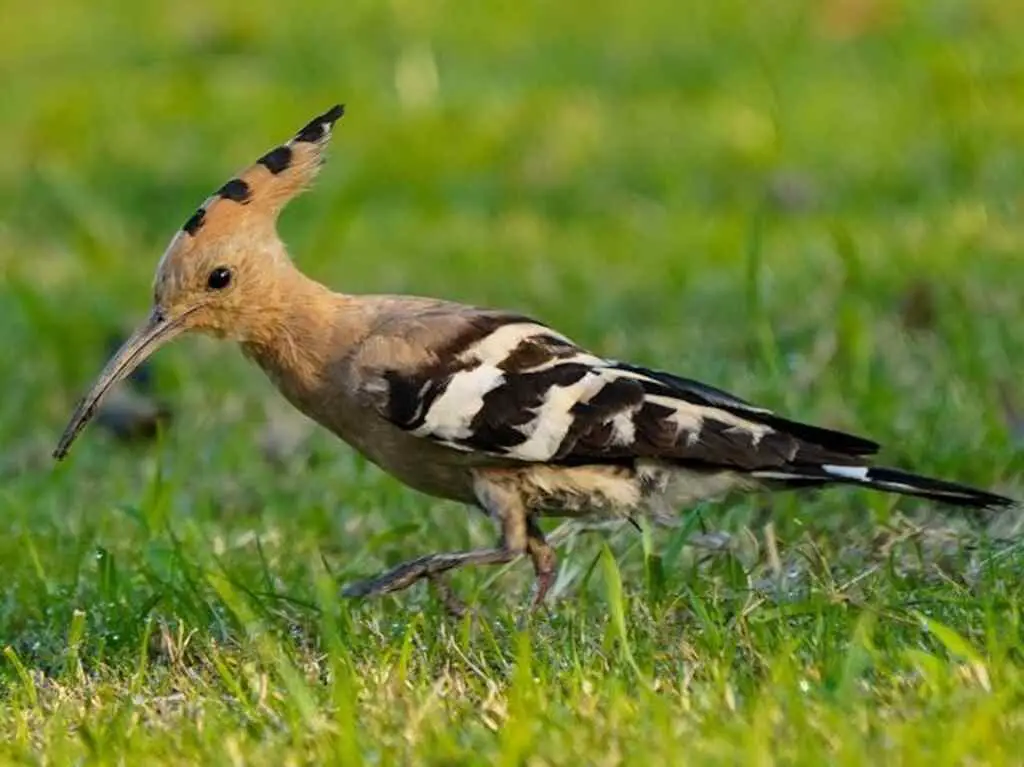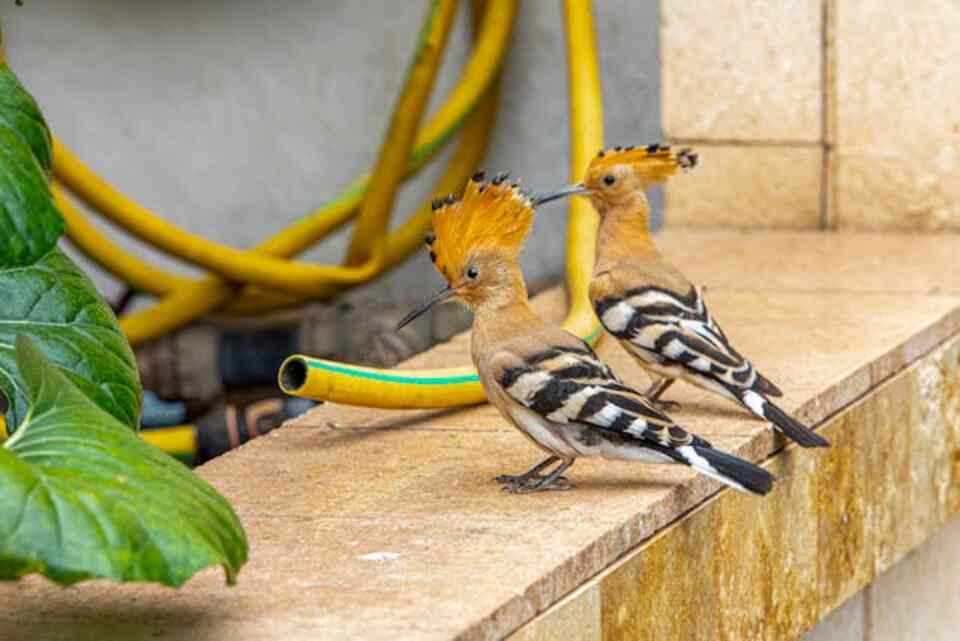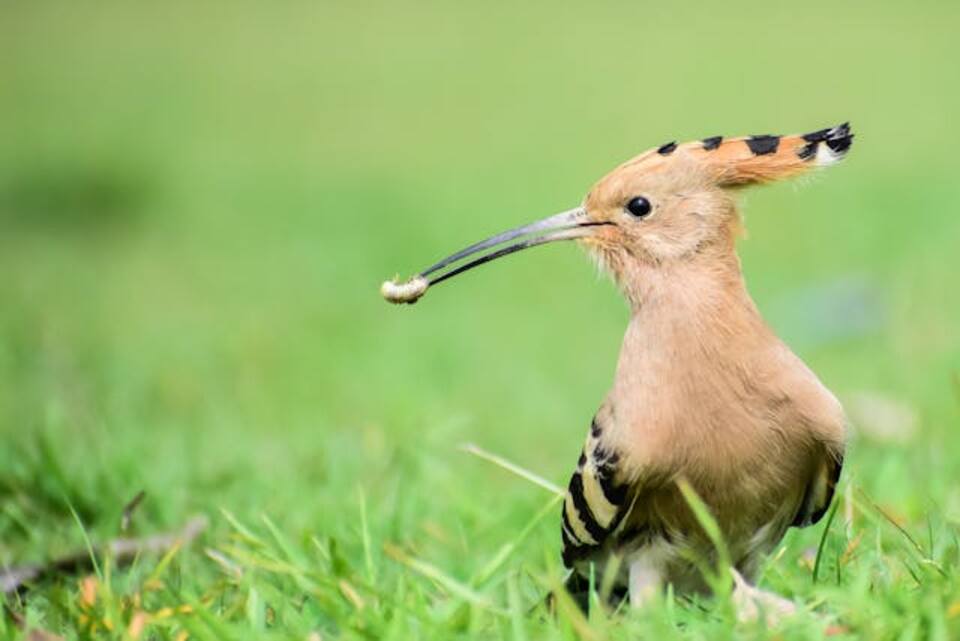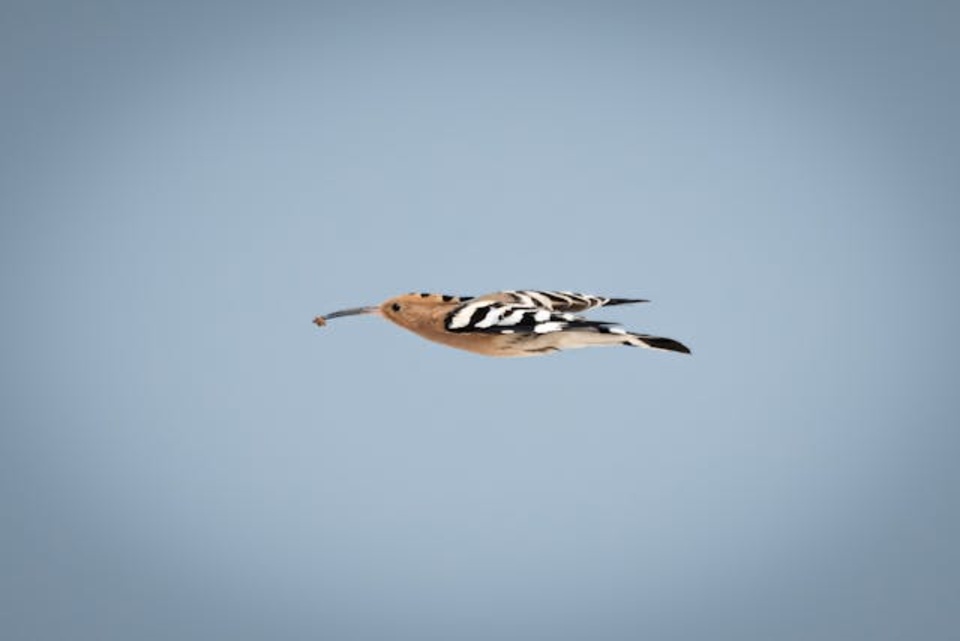The Eurasian Hoopoe (Upupa epops) is a striking and unique bird that has captured the imagination of people for centuries. With its distinctive crown of feathers and bold black-and-white wing patterns, this avian wonder stands out in the world of ornithology. In this comprehensive guide, we’ll explore every aspect of the Eurasian Hoopoe, from its physical characteristics to its cultural significance, and delve into the intricacies that make this bird a true marvel of nature.
Table of Contents
- 1 Physical Characteristics: A Bird Like No Other
- 2 Habitat and Distribution: A Bird of Many Lands
- 3 Diet and Foraging Behavior: The Art of the Hunt
- 4 Behavior and Social Structure: A Life of Intrigue
- 5 Reproduction and Life Cycle: From Egg to Adult
- 6 Conservation Status: Challenges and Opportunities
- 7 Cultural Significance: A Bird of Legend and Lore
- 8 Observing Hoopoes: Tips for Birdwatchers
- 9 Conclusion: A Feathered Wonder
- 10 Author
Physical Characteristics: A Bird Like No Other
The Eurasian Hoopoe is a medium-sized bird that immediately catches the eye with its extraordinary appearance. Let’s dive into the details that make this bird so visually remarkable.
Distinctive Crest: The Crown Jewel
One of the most striking features of the Eurasian Hoopoe is its crest. This fan-like arrangement of feathers on the bird’s head can be raised or lowered at will, creating a mesmerizing display. The crest typically consists of rusty orange feathers tipped with black, giving the bird a regal appearance.
The crest serves multiple purposes:
- Communication: Hoopoes use their crest to signal various emotions and intentions to other birds.
- Courtship display: Males often raise their crests to impress potential mates.
- Intimidation: When threatened, a Hoopoe may erect its crest to appear larger and more imposing to predators.
Plumage: A Symphony of Colors
The Hoopoe’s body is primarily covered in a soft, pinkish-brown plumage. This base color is beautifully contrasted by bold black and white stripes on its wings and tail. When in flight, these stripes create a butterfly-like pattern, making the Hoopoe easily identifiable even from a distance.
The complexity of the Hoopoe’s plumage doesn’t end there:
- Head and neck: A delicate pinkish-brown, sometimes with a slightly lighter shade on the throat.
- Breast and belly: Usually a lighter shade of the main body color, often with subtle streaking.
- Back: A rich, warm brown that complements the overall color scheme.
- Tail: Black with a distinctive white band across the middle, visible in flight.
This intricate color pattern serves as excellent camouflage when the bird is foraging on the ground, blending seamlessly with the earth tones of its typical habitats.
Bill and Eyes: Tools of the Trade
The Hoopoe possesses a long, thin, and slightly downcurved bill, perfectly adapted for probing into soil and crevices in search of food. Its eyes are small and dark, giving it a keen sense of sight for spotting insects and other prey.
The bill of the Eurasian Hoopoe is a marvel of natural engineering:
- Length: Typically 5-6 cm long, about half the length of the bird’s head and body.
- Sensitivity: Packed with nerve endings, allowing the bird to detect prey movement underground.
- Flexibility: Can open wide to grasp larger prey items.
- Strength: Despite its slender appearance, the bill is strong enough to dig into hard soil.
Size and Shape: Compact yet Elegant
Here’s a table for the measurements:
| Measurement | Range |
|---|---|
| Length | 25-32 cm (9.8-12.6 inches) |
| Wingspan | 44-48 cm (17.3-18.9 inches) |
| Weight | 46-89 g (1.6-3.1 oz) |
The Eurasian Hoopoe has a compact body with short legs, making it well-suited for both ground foraging and perching. Its wings are broad and rounded, allowing for an undulating flight pattern that is quite distinctive.
Sexual Dimorphism: Subtle Differences
While male and female Hoopoes are similar in appearance, there are some subtle differences:
- Females tend to be slightly duller in color, smaller, and lighter in weight.
- Males often have more vibrant plumage, especially during the breeding season.
- The male’s black tail band may be slightly broader than the female’s.
Habitat and Distribution: A Bird of Many Lands
The Eurasian Hoopoe is a widespread species with a vast distribution range, spanning across Europe, Asia, and North Africa. Its adaptability to various habitats contributes to its success as a species.
Preferred Habitats
Hoopoes thrive in a variety of environments, including:
- Open woodlands
- Savannas
- Grasslands
- Farmlands
- Orchards
- Urban parks and gardens
- Steppes and semi-deserts
- Cork oak forests (in parts of the Mediterranean)
- Olive groves
- Vineyards
These birds prefer areas with short or sparse vegetation, which allows them easy access to the ground for foraging. They also require suitable nesting sites, such as tree cavities, rock crevices, or even man-made structures.
Adaptations to Different Habitats
The Hoopoe’s success across various habitats is due to several adaptations:
- Versatile diet: Able to feed on a wide range of insects and small prey.
- Flexible nesting behavior: Can use both natural cavities and man-made structures for nesting.
- Thermoregulation: Can cope with a wide range of temperatures, from hot deserts to cooler temperate regions.
- Water conservation: Adapted to survive in arid environments with limited water sources.
Geographic Range
The Eurasian Hoopoe’s range is extensive, covering:
- Most of Europe (except for the northernmost regions)
- North Africa
- Middle East
- Central Asia
- Indian Subcontinent
- Parts of Southeast Asia
Some populations are migratory, while others are resident year-round, depending on the region and local climate conditions.
Migration Patterns
The migratory behavior of Hoopoes varies across their range:
- European populations: Generally migrate to Africa for the winter, crossing the Mediterranean and Sahara.
- Asian populations: Many birds from northern parts of Asia move southward for winter.
- African and southern Asian populations: Tend to be more sedentary, with only local movements.
Migration routes and timing can be affected by factors such as:
- Climate change
- Habitat alterations
- Food availability
- Weather patterns
Diet and Foraging Behavior: The Art of the Hunt
The Eurasian Hoopoe is primarily insectivorous, with a diet that reflects its adaptability and opportunistic nature.
Main Food Sources
- Insects (various species)
- Beetles and their larvae
- Caterpillars
- Ants
- Crickets and grasshoppers
- Flies and their larvae
- Spiders
- Small reptiles (e.g., lizards)
- Frogs
- Plant matter (occasional)
- Berries
- Seeds
Foraging Techniques
Hoopoes employ several techniques to catch their prey:
- Probing: Using their long bills to search for insects in soil, leaf litter, and crevices.
- Ground foraging: Walking or running along the ground, picking up visible insects.
- Aerial catches: Occasionally catching flying insects in mid-air.
- Bark gleaning: Searching for insects hidden in tree bark.
- Leaf turning: Flipping over leaves to find hidden prey.
The bird’s bill is specially adapted for its foraging habits. When closed, it appears narrow, but it can open widely to catch larger prey. The bill also has sensitive nerve endings, allowing the Hoopoe to detect movement of insects underground.
Seasonal Diet Variations
The Hoopoe’s diet can vary seasonally based on prey availability:
- Spring and Summer: Focus on caterpillars, beetles, European mole crickets, and pine processionary moths during the breeding season, as well as other abundant insects.
- Autumn: Increased consumption of ants and their pupae.
- Winter: Greater reliance on overwintering insects and their larvae.
Feeding Behavior in Different Habitats
Hoopoes adjust their feeding strategies based on their environment:
- Agricultural lands: Often follow plows to catch exposed insects and larvae.
- Urban areas: Adapt to foraging in lawns, parks, and gardens.
- Arid regions: Concentrate on prey found near water sources or under rocks.
Behavior and Social Structure: A Life of Intrigue
The Eurasian Hoopoe exhibits fascinating behaviors that set it apart from many other bird species. From its unique vocalizations to its defensive mechanisms, the Hoopoe’s behavior is a subject of great interest to ornithologists and bird enthusiasts alike.
Vocalizations: The Signature “Hoop-Hoop-Hoop”
The Hoopoe’s name is onomatopoeic, derived from its distinctive call. The typical vocalization is a soft “hoop-hoop-hoop” sound, repeated several times. This call is primarily used by males during the breeding season to attract mates and establish territory.
Other vocalizations include:
- Alarm calls: A harsh, raspy sound when threatened.
- Courtship calls: Softer, more melodious versions of the typical call.
- Begging calls: Made by chicks to solicit food from parents.
- Contact calls: Short, soft notes used to maintain communication within family groups.
Social Behavior: Solitary yet Sociable
Eurasian Hoopoes are generally solitary birds, especially outside the breeding season. However, they may form small, loose flocks during migration or in winter feeding grounds. During the breeding season, they form monogamous pairs.
Interesting social behaviors include:
- Territorial displays: Males perform aerial displays and call frequently to establish and defend territories.
- Courtship feeding: Males often present food items to females as part of the courtship ritual.
- Cooperative breeding: In some populations, young from previous broods may help in raising new chicks.
- Dust bathing: Hoopoes often engage in communal dust bathing, which serves both social and practical (parasite control) purposes.
Defensive Mechanisms: Nature’s Little Stink Bomb
When threatened, Hoopoes have a rather unusual defense mechanism. The female and young can secrete a foul-smelling liquid from their preen gland, which they use to deter predators. This has earned the Hoopoe the nickname “the bird that dirties its own nest.”
Additional defensive behaviors include:
- Freezing: Remaining motionless to avoid detection.
- Spreading display: Opening wings and tail to appear larger.
- Crest raising: Erecting the crest to intimidate potential threats.
- Mimicry: In some cases, mimicking the hiss of a snake to deter predators.
Reproduction and Life Cycle: From Egg to Adult
The breeding habits of the Eurasian Hoopoe are as fascinating as the bird itself. Let’s explore the journey from courtship to fledging in greater detail.
Courtship and Pair Formation
Male Hoopoes perform elaborate courtship displays to attract females. These displays often include:
- Calling loudly and repeatedly
- Raising and lowering the crest
- Wing-spreading displays
- Offering food to the female
- Aerial displays, including short, buoyant flights
- Bill fencing, where males touch bills in a fencing-like manner
Once a pair is formed, they remain monogamous for the breeding season. In some cases, pairs may reunite in subsequent breeding seasons if both birds return to the same area.
Nesting Habits
Hoopoes are cavity nesters, preferring:
- Natural tree hollows
- Crevices in rocks or walls
- Nest boxes (in urban or suburban areas)
- Abandoned woodpecker holes
- Spaces under building eaves or in barns
The female typically lays 4-12 eggs, which are pale blue when first laid but quickly become stained and appear dirtier. This is partly due to the unsanitary conditions of the nest, which paradoxically help protect the eggs and chicks from predators.
Nest Construction and Maintenance
While Hoopoes don’t build elaborate nests, they do engage in some nest preparation:
- Minimal lining of the cavity with grass, leaves, or feathers
- Regular removal of fecal sacs from young chicks (unlike many cavity nesters)
- Application of antimicrobial secretions from their preen glands to the nest
Incubation and Chick Rearing
This format clearly presents the information about each stage and its duration.
| Stage | Duration |
|---|---|
| Incubation | 15-18 days |
| Nestling period | 26-29 days |
Both parents participate in incubation and chick-rearing, although the female takes on a larger role. The male brings food to the female during incubation and early nestling stages.
Chick development follows this general timeline:
- Hatching: Chicks hatch asynchronously over 2-3 days.
- Early nestling stage: Chicks are altricial, born naked and blind.
- Feather development: Pin feathers appear around day 5-7.
- Eyes opening: Occurs around day 7-9.
- Full feathering: Achieved by day 20-22.
Fledging and Independence
Young Hoopoes fledge after about four weeks but may return to the nest to roost for several days afterward. They become fully independent within a few weeks of fledging.
Post-fledging behavior includes:
- Short flights near the nest site, gradually increasing in distance
- Continued feeding by parents for 1-2 weeks after fledging
- Development of foraging skills through observation and practice
- Dispersal from the natal area, typically within 2-3 months
Breeding Success and Challenges
Several factors influence the breeding success of Hoopoes:
- Predation: Eggs and chicks are vulnerable to predators like snakes, rodents, and other birds.
- Weather conditions: Extreme temperatures or heavy rainfall can impact nestling survival.
- Food availability: Successful breeding depends on abundant insect populations.
- Human disturbance: Urbanization and agricultural practices can disrupt nesting sites.
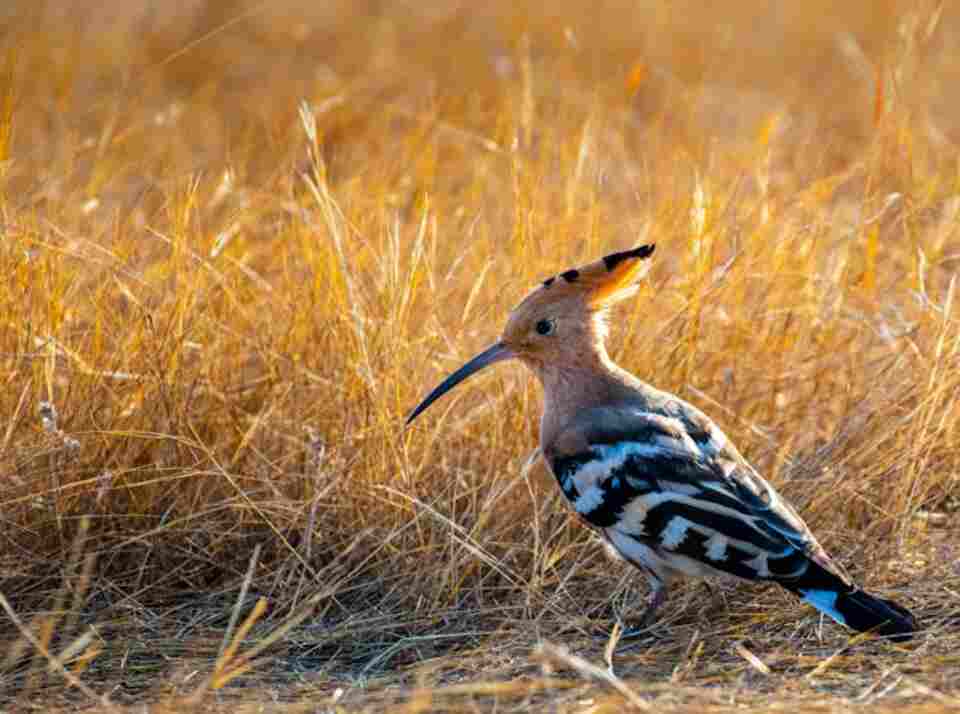
Conservation Status: Challenges and Opportunities
While the Eurasian Hoopoe is not currently considered globally threatened, it faces various challenges in different parts of its range.
Current Status
The International Union for Conservation of Nature (IUCN) lists the Eurasian Hoopoe as a species of “Least Concern” due to its large range and stable global population. However, local declines have been observed in some regions.
Population Trends
Population trends vary across the Hoopoe’s range:
- Western Europe: Declines observed in some countries, stabilization in others
- Eastern Europe and Asia: Generally stable populations
- North Africa and Middle East: Some local declines reported
Threats
- Habitat loss due to urbanization and agricultural intensification
- Pesticide use reducing insect prey availability
- Climate change affecting migration patterns and breeding success
- Hunting (in some parts of its range)
- Collision with vehicles and structures
- Predation by domestic cats in urban and suburban areas
- Competition for nesting cavities with invasive species
Conservation Efforts
Various measures are being taken to protect and support Hoopoe populations:
- Habitat preservation and restoration
- Creation of protected areas
- Maintenance of traditional agricultural practices that benefit Hoopoes
- Promotion of organic farming practices
- Reduction of pesticide use
- Encouragement of insect-friendly farming methods
- Installation of nest boxes in suitable habitats
- Provision of artificial nesting sites in areas lacking natural cavities
- Monitoring and maintenance of nest box programs
- Public education and awareness programs
- Citizen science projects to monitor Hoopoe populations
- Educational initiatives to promote bird-friendly gardening practices
- Research and monitoring
- Studies on migration patterns and habitat use
- Assessment of the impacts of climate change on Hoopoe populations
- Legal protection
- Inclusion in national and international conservation legislation
- Enforcement of hunting restrictions where applicable
Success Stories
Several conservation initiatives have shown promising results:
- Switzerland: A national action plan led to a significant increase in Hoopoe populations in the Valais region.
- Spain: Conservation efforts in olive groves and cork oak forests have helped maintain stable Hoopoe populations in parts of Andalusia and Extremadura.
- Israel: The creation of artificial nesting sites in agricultural areas has boosted local Hoopoe numbers.
- Netherlands: Reintroduction programs and habitat management have led to the return of breeding Hoopoes in some regions after decades of absence.
These success stories demonstrate that targeted conservation efforts can have a significant positive impact on Hoopoe populations, providing hope for the species’ future in areas where they have declined.
Cultural Significance: A Bird of Legend and Lore
The Eurasian Hoopoe has played a significant role in human culture, appearing in myths, legends, and artistic representations across its range. Its distinctive appearance and behavior have inspired countless stories and symbolic meanings in various cultures.
In Ancient Egypt
The Hoopoe was considered sacred in ancient Egypt, often depicted in hieroglyphics and associated with the god Horus. Some key aspects of its significance include:
- Symbol of kingship: The Hoopoe’s crest was seen as resembling a crown, associating it with royalty.
- Guide to the underworld: In some myths, the Hoopoe was believed to guide the souls of the dead.
- Artistic representations: Hoopoes were frequently depicted in tomb paintings and on amulets.
In Islamic Tradition
In Islamic folklore, the Hoopoe is mentioned in the Quran as a messenger of King Solomon, revered for its wisdom and ability to find water underground. The story highlights:
- Intelligence: The Hoopoe is portrayed as a wise and knowledgeable bird.
- Communication: It serves as a messenger between Solomon and the Queen of Sheba.
- Special abilities: The bird’s supposed skill in finding water made it valuable in desert regions.
In European Culture
Various European cultures have folklore surrounding the Hoopoe, often associating it with themes of wisdom, prophecy, or sometimes negative omens:
- Ancient Greece: The Hoopoe features in Aristophanes’ play “The Birds” as a former king transformed into a bird.
- Medieval Europe: Sometimes associated with theft due to its habit of probing the ground, leading to superstitions about it stealing gold.
- Heraldry: The Hoopoe appears in some European coats of arms, symbolizing nobility or virtue.
In Asian Traditions
The Hoopoe also holds significance in various Asian cultures:
- Persian literature: Featured in poetry and prose as a symbol of virtue and spiritual guidance.
- Chinese folklore: Sometimes associated with the Phoenix and considered a harbinger of good fortune.
- Indian mythology: Appears in some stories as a wise and helpful creature.
Modern Cultural References
The Hoopoe continues to inspire art, literature, and popular culture:
- National bird: Declared the national bird of Israel in 2008.
- Literature: Featured in works by authors such as Salman Rushdie and Vladimir Nabokov.
- Art: A popular subject in wildlife art and photography.
- Logos and emblems: Used in various organizational logos, often symbolizing uniqueness or wisdom.
Observing Hoopoes: Tips for Birdwatchers
For those interested in observing Eurasian Hoopoes in the wild, here are some detailed tips and best practices:
When and Where to Look
- Timing:
- Best observed during spring and summer in most of Europe and Asia.
- Early morning and late afternoon are peak activity times.
- In warmer regions, they may be active throughout the day.
- Habitat: Look for them in open areas with short grass, such as:
- Parks and golf courses
- Orchards and vineyards
- Agricultural fields, especially after plowing
- Edges of woodlands
- Mediterranean scrubland
- Geographic hotspots:
- Southern Europe: Spain, Portugal, southern France, Italy
- Eastern Europe: Hungary, Romania, Bulgaria
- Middle East: Israel, Turkey
- North Africa: Morocco, Tunisia
- South Asia: India, particularly in agricultural areas
Observation Techniques
- Visual identification:
- Watch for their distinctive undulating flight pattern
- Look for birds probing the ground with their long bills
- Scan suitable habitats for their unique silhouette when perched
- Auditory clues:
- Listen for their characteristic “hoop-hoop-hoop” call
- Early morning is often the best time to hear males calling
- Behavior to watch for:
- Foraging on the ground
- Crest-raising displays
- Courtship rituals during breeding season
- Feeding trips to and from nest sites
Equipment and Preparation
- Binoculars: 8×42 or 10×42 magnification is ideal for most situations
- Field guide: A good bird guide covering European or Asian species
- Camera: For documentation and sharing observations
- Appropriate clothing: Neutral colors and comfortable footwear for walking in various terrains
- Notebook: For recording observations, behaviors, and locations
Ethical Birdwatching
- Respect the birds: Maintain a safe distance to avoid disturbing them, especially during breeding season
- Follow local regulations: Adhere to protected area guidelines and private property rules
- Minimize habitat impact: Stick to designated paths and avoid trampling vegetation
- Use calls responsibly: Avoid overuse of recorded bird calls, which can stress the birds
- Share knowledge: Report sightings to local bird organizations to contribute to conservation efforts
Joining Guided Tours
For those new to birdwatching or unfamiliar with local Hoopoe habitats, joining a guided tour can be beneficial:
- Local expertise: Guides often know the best spots and times for Hoopoe sightings
- Educational opportunity: Learn about Hoopoe behavior and ecology from experienced naturalists
- Equipment access: Some tours provide high-quality binoculars or spotting scopes
- Conservation support: Many tours contribute to local conservation efforts
Conclusion: A Feathered Wonder
The Eurasian Hoopoe stands as a testament to the incredible diversity and beauty of the avian world. From its striking appearance to its fascinating behaviors, this bird continues to captivate scientists and nature enthusiasts alike. As we face the challenges of a changing world, the conservation of species like the Hoopoe becomes ever more crucial, ensuring that future generations can continue to marvel at these feathered wonders.
The Hoopoe’s ability to adapt to various habitats, from ancient forests to modern urban parks, showcases the resilience of nature. However, this adaptability should not be taken for granted. The ongoing threats of habitat loss, climate change, and human interference remind us of the delicate balance required to maintain healthy ecosystems.
As we conclude this comprehensive guide, we hope you’ve gained a deeper appreciation for the Eurasian Hoopoe and are inspired to learn more about the diverse avian species that share our planet. Whether you’re a seasoned ornithologist, a casual birdwatcher, or simply someone who enjoys the beauty of nature, the Hoopoe offers a glimpse into the complex and beautiful world of birds.
Remember, every bird has a story to tell, and the Hoopoe’s tale is one of resilience, adaptation, and timeless beauty. By understanding and appreciating creatures like the Hoopoe, we can foster a greater connection to the natural world and become better stewards of our shared environment.
So, the next time you hear a soft “hoop-hoop-hoop” or catch a glimpse of a crown-like crest bobbing among the grass, take a moment to appreciate the wonder that is the Eurasian Hoopoe – a true avian marvel that continues to enchant and inspire across cultures and continents.

